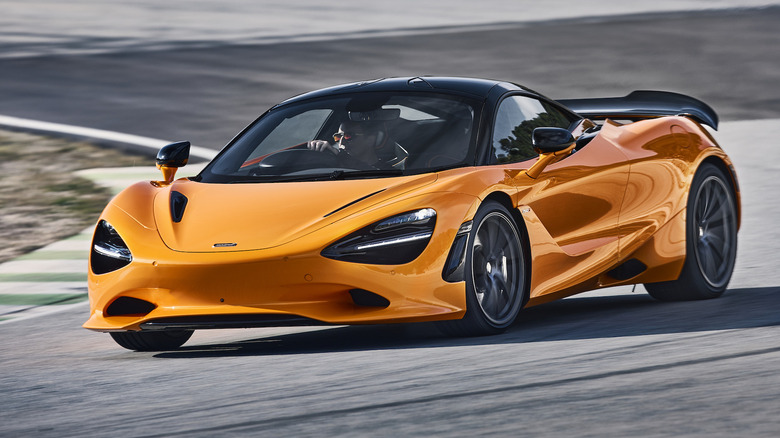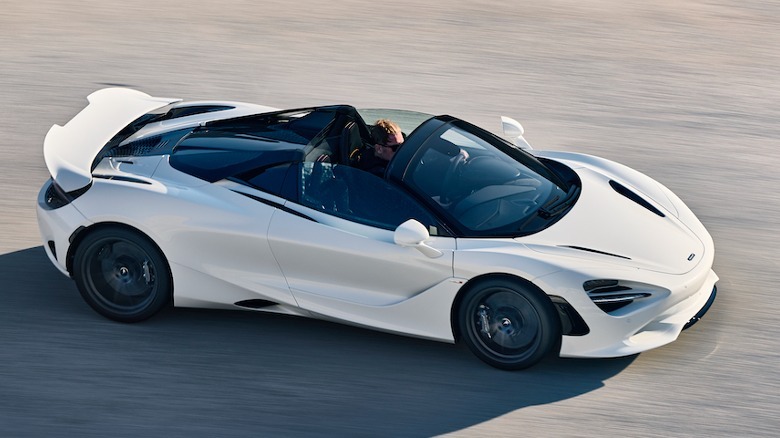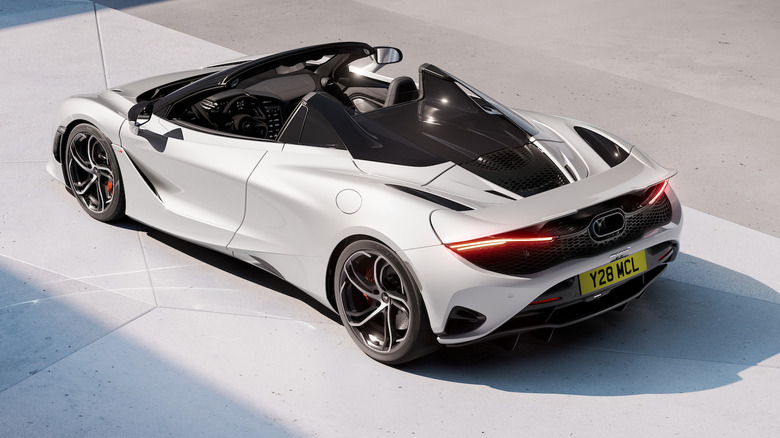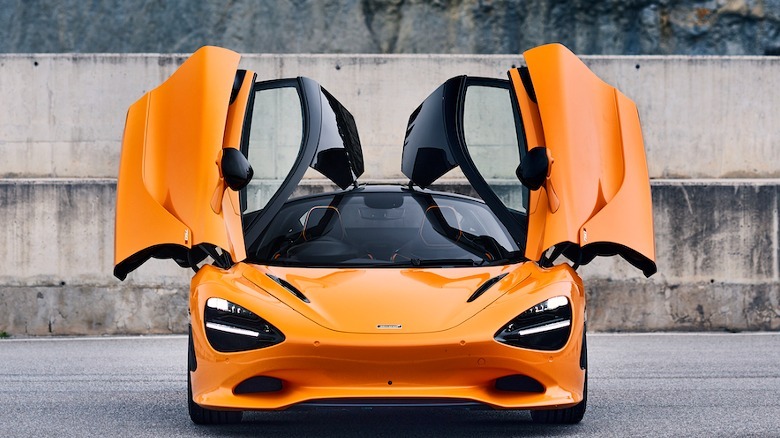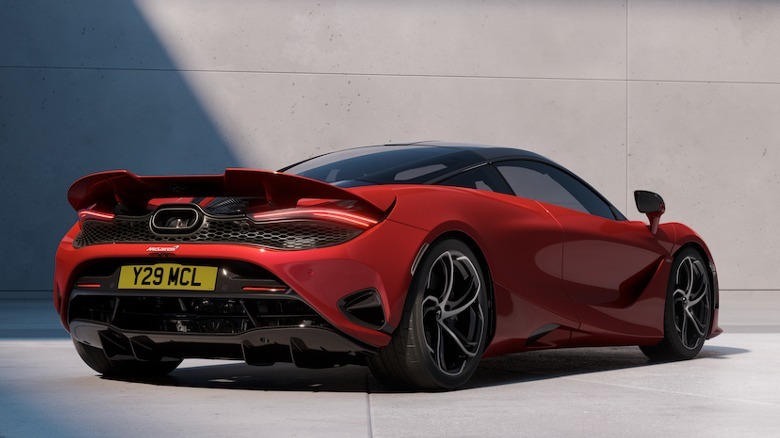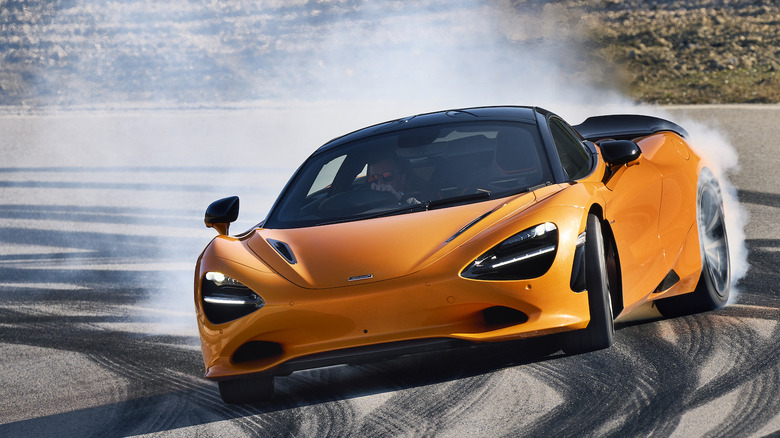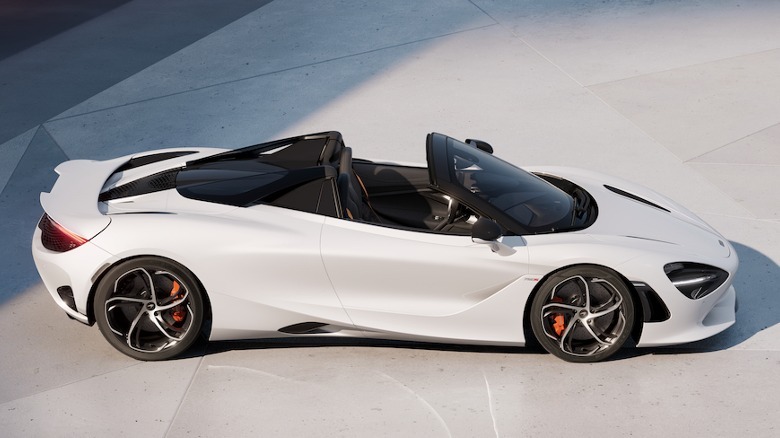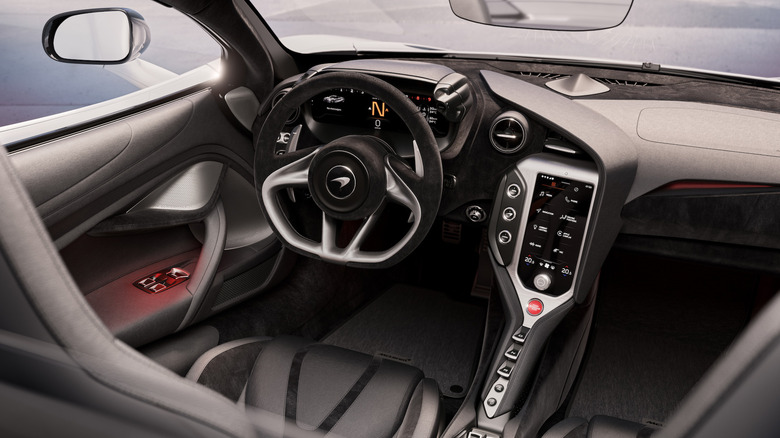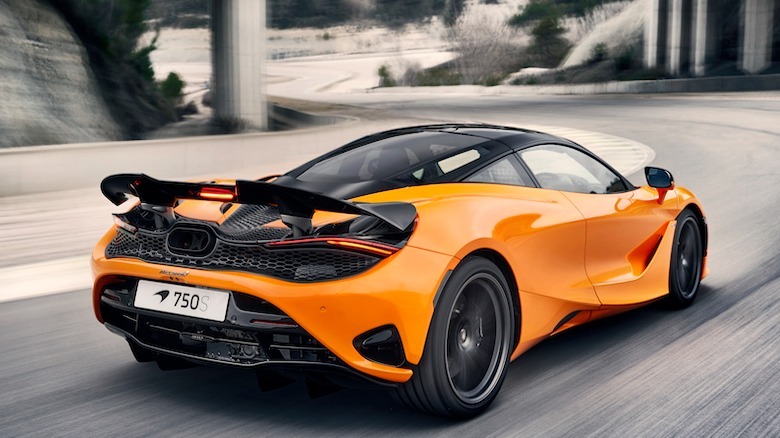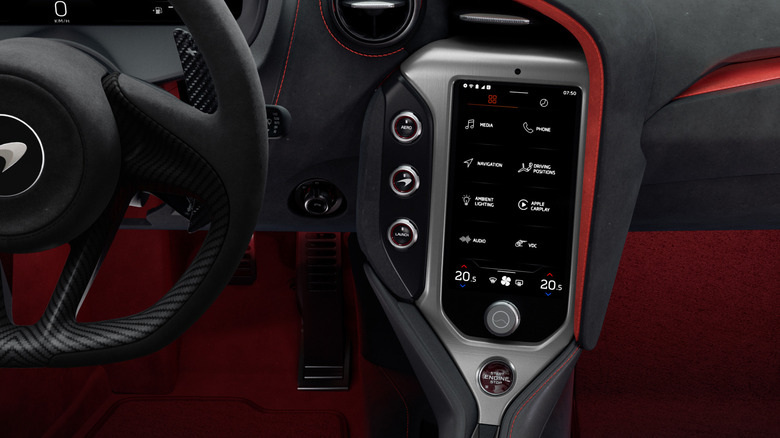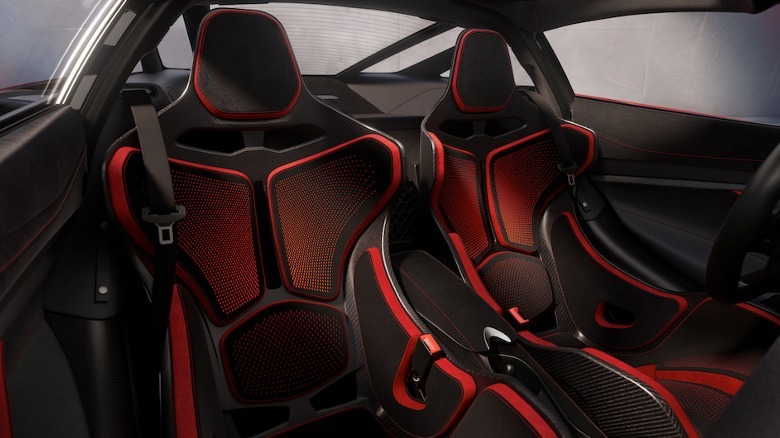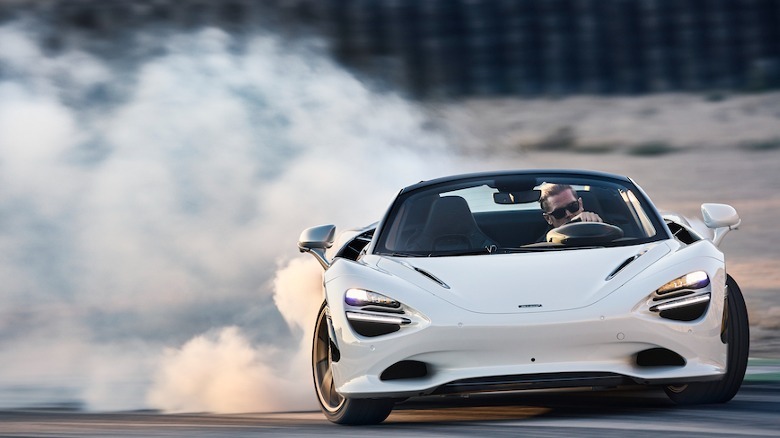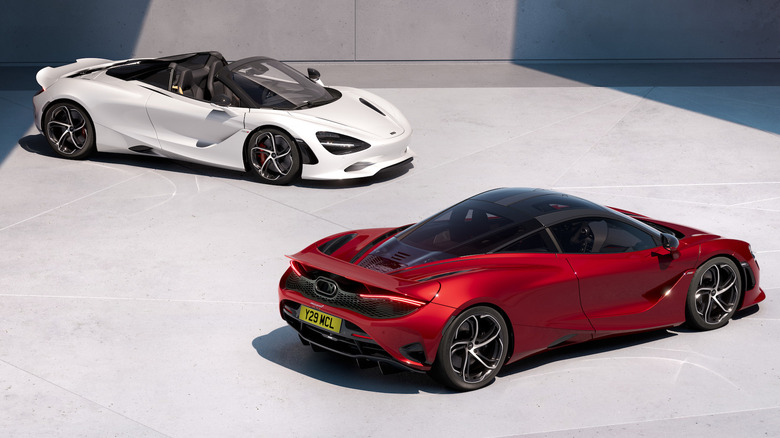McLaren 750S Revealed As Scalpel-Sharp Supercar Upgrade
The McLaren 750S takes a modern-day supercar icon and promises to crank up the fun quotient. The British automaker wasn't new to road cars when the 720S launched six years ago, but it's fair to say the "super series" coupe marked its transition into the big leagues. Unapologetic styling and genuinely wild performance were combined with the sort of everyday usability that supercars simply weren't known for.
Yes, the 720S could do zero to 60 mph in under three seconds, but you could also drive it to the market and fit an unexpected amount in its front trunk. While nobody buys a supercar with practicality as their first criterion, the ability to treat the 720S as an atypical daily driver — combined with its definite form-follows-function approach to speed — helped carve out a space among the options from more established brands.
The arrival of the 720S Spider shortly after only went to further underscore McLaren's engineering capabilities, slicing off the roof with no extra body stiffening required, and with minimal impact on overall performance. Still, six years is a long time in sports cars, and while the 720S' pace may not have dimmed, supercar buyers expect their garages to be kept fresh. That's where the new McLaren 750S comes in.
A refinement of the purist's supercar
McLaren has, wisely and unsurprisingly, not thrown out its prior work. As the name suggests, the 750S is a refinement and improvement on the existing supercar. Instantly recognizable, yes — those dihedral doors on the coupe are unmistakable — but with more speed, more user-friendly technology, and the promise of a better soundtrack along the way.
The M840T twin-turbocharged 4.0-liter V8 gas engine now produces 740 horsepower and 590 lb-ft of torque, and has a heady 8,500 rpm redline. It's paired with a 7-speed SSG transmission, which McLaren says has shorter ratios to optimize acceleration. A new "limit downshift" transmission option is available in Sport and Track modes, holding the engine at the redline when the driver downshifts.
The result is a zero to 60 mph time of 2.7 seconds, while zero to 124 mph comes in just 7.2 seconds (or 7.3 seconds for the 750S Spider). The top speed is 206 mph.
Lighter all round
A more potent engine — with 30 PS more, hence the name change, and 30 NM more torque — alone isn't enough to account for that speed improvement, however. McLaren also put the car on a diet, trimming over 66 pounds to bring the coupe down to 2,815 pounds dry or 3,062 pounds DIN (or 2,923 pounds dry/3,170 pounds DIN for the Spider) in its lightest configuration. The result is the highest power-to-weight ratio in the segment, McLaren boasts.
To help achieve that, the 750S gets the carbon fiber racing seats as standard — they were optional on the 720S — trimming almost 39 pounds, while the 10-spoke forged alloy wheels are more than 30 pounds lighter than the old standard rims. McLaren will offer Pirelli P ZERO, P ZERO Cross, and P ZERO Trofeo R tires from the factory, while dealers will also offer P ZERO Winter rubber. Four pounds have been cut from the driver instrumentation display, and the windshield glass is 3.5 pounds lighter than before.
At its heart is the carbon fiber monocoque, strong enough that the Spider needs no additional reinforcement. Its retractable hard top can open in under 11 seconds at speeds of up to 31 mph, and can optionally be fitted with electrochromic glass that tints at the touch of a button.
A familiar design with more bespoke detailing
Outside, the 750S' nose section is lower, with an extended front splitter. The front track has been widened by 6 mm, and there are narrower "eye socket" air intakes enclosing the headlamps. The headlamp surrounds are now available either in body color or in carbon fiber. McLaren has added new sill air intakes along with new rear wheel-arch vents, and there are optional carbon fiber front and rear bumper vents.
At the back, there's a larger rear wing with 20% more surface area. Longer and re-profiled, it helps increase downforce in Aero mode, or trims drag for acceleration. For maximum braking, it can deploy to shed speed far more dramatically, while the overall weight has been cut by 3.5 pounds thanks to a more judicious application of carbon fiber.
A cut-out in the center ensures visibility, as well as avoiding scorching from the exhaust. A new central exist stainless steel sports exhaust is standard, 4.8 pounds lighter than the old 720S system, with the promise of a sharper and clearer tone. McLaren allows drivers to let more of that into the cabin in the Spider, thanks to a separate opening rear glass window. However, it has also tuned the engine mounts to avoid any unpleasant droning making it inside.
The cabin itself is the usual blend of metal, leather, carbon fiber, and McLaren's own custom switchgear. A new driver display is now mounted to the steering column, with Powertrain and Handling controls on the side. A custom configuration of aero, handling, powertrain, and transmission settings can now be stored to a new McLaren Control Launcher button.
Luxury at speed
Another new button gives the nose lift a dedicated shortcut, with the useful front raise taking place in four seconds, versus 10 seconds for the 720S. The rear and surround view cameras are higher resolution, while in the center console there's a new, more detailed 8-inch optically-bonded touchscreen. McLaren's latest infotainment system adds Apple CarPlay support, and there are USB-C and USB-A ports with fast charging, plus a more powerful amp for the optional Bowers & Wilkins audio system.
Other options include a glazed powertrain window on the coupe and a choice of full Nappa leather or Alcantara/Nappa upholstery. New ambient lighting has been added, while the steering column is now electrically adjusted as standard, though the steering itself is still electro-hydraulically assisted.
It's been tuned to be faster and more linear, and — combined with 3% softer front springs and 4% stiffer rear springs — improve cornering balance, feedback, and agility. There are still the usual three Handling modes (Comfort, Sport, and Track) with semi-active dampers for greater balance as well as more high-speed compliance.
A McLaren Senna-inspired brake system uses 15.4-inch front carbon ceramic discs with 6-piston calipers and 15-inch rear with 4-piston calipers. An optional track brake upgrade uses specially created discs — taking seven months to make — that are 60% stronger and have four times the thermal conductivity. Either way, there's a new brake booster and F1-inspired integrated caliper cooling.
Six figures of super-fast fun
Overall, McLaren says, the 750S has been designed to deliver the best of the vehicle dynamics from the 720S and the Longtail family: a coupe or convertible even more at home on the track or on a long-distance cruise. To double down on that reassurance, there's a three-year warranty (with unlimited mileage) along with a three-year scheduled maintenance and service plan.
McLaren's Extended Warranty is also available, in one or two-year periods, until the 750S is 15 years old, with benefits also transferring to new owners should the car be sold. The automaker is counting on that to help preserve residual values, too, even as attention may be swayed toward the even-more-practical McLaren Artura hybrid.
As for pricing, the 750S Coupe will start at $324,000, while the 750S Spider will kick off at $345,000. Both will also incur $5,500 in destination fees and $2,240 for the Americas Accessory Pack. The order books open today, with the first cars expected to arrive in the U.S. in Q3 2023.
